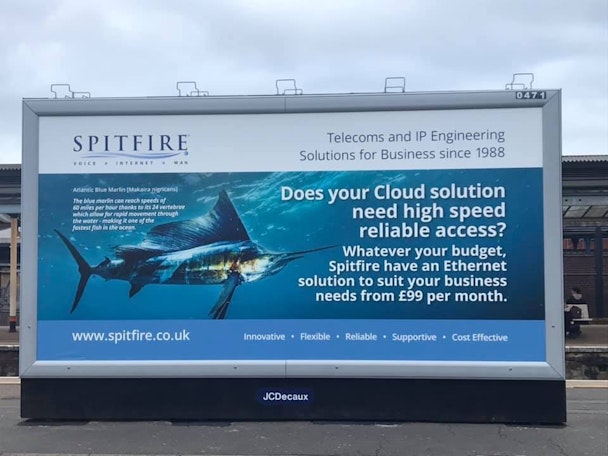Kevin Chesters: Why does B2B advertising have to be ugly and crap?
Last week I did my first bit of business travel in ages. As I walked through Heathrow my eyes and ears were repeatedly assaulted by a cacophonous avalanche of cliché, both verbal and visual, under the guise of B2B advertising.

Why does B2B advertising have to be ugly and crap?
I didn’t even want to start to imagine how much all the media must have cost the respective vendors punting their mostly-tech wares at me. My professional self was pretty embarrassed on behalf of the set of big clients and big agencies who had signed it off and spent the money. It was universally ugly, boring and utterly meaningless.
You know the kind of messaging I’m talking about, right? 'Powering the Possible', 'Enabling empowering possibilities', 'The possibility of empowering enablement' and 'The power of enabling the possible'. It was all as anodyne as it was lazy.
It struck me that all of it was targeted at my 'business self’. That mythical creature that inhabits this world of 'possibilities' and 'empowerment' and is surrounded only by people who look like Gary Vaynerchuk, endlessly high-fiving at the top of escalators. All the work reminded me of that amazing ‘tagline generator’ meme.

When I got to the business lounge, I opened my free copy of The Economist and was further drowned by the same fridge poetry of meaningless words and an equally tiresome smorgasbord of suited-up Getty Images. But something was very weird. My eyes had been opened like the main character in John Carpenter's 'They Live'. I looked around at all the other people in the business lounge. They weren’t a set of these mythical identikit ‘businessmen’ and ‘business women’. They were like me and all my mates who work 'in business'. They were mums and dads. They were people who go to gyms, drive cars, visit supermarkets. They were 'Consumers'. In short, they were real people with real lives and real human brains.
Businesspeople are still people, with the same evolutionary brains. You don’t switch off your heart when you put on a tie. Humans in business respond like all other humans – emotion first, logic second. We know that creativity is the key driver of effectiveness. We know emotion in advertising works. So why is this suddenly different for B2B and B2C? (Spoiler: It isn’t. All research proves it).
Science is seriously on my side here. We humans respond better to what looks nice. It’s called the Aesthetic Usability Effect. Masaaki Korosu and Kaori Kashimura from Hitachi Design Centre in 1995 tested 26 variations of an ATM UI and found that there was a huge correlation between participants ratings of aesthetic appeal and perceived ease of use. People think things are superior if they look nice.
As a corporate business you want people to trust you, like you, interact with you, buy from you. You want your reception to look good. You want your office environment to look good for clients. So why would you then let your advertising be a lazy collection of cliched stock shots and word salad? Follow the same rules you know work – good creative sells. Always.
Google did a piece of research on this back in 2012. This proved that emotion works just as well (in fact better) in the B2B world compared to B2C. They studied a vast number of B2C and B2B brands to check people’s emotional engagement with them. The survey showed that people actually had a higher level of emotional connection with B2B brands compared to B2C brands (in fact, most of the B2B brands had an astonishingly high level of emotional trust - above 50% - compared to the average 10-40% for B2C brands). According to Google this indicated that: "B2B customers are significantly more emotionally connected to their vendors and service providers than consumers.”
The survey stated that over 50% of B2B purchasers were more likely to buy from a product or service that they ‘personally’ valued. It went on to show that 71% of B2B buyers who had an emotional connection to their vendors ended up buying products/services from that vendor. Google concluded: “We like to think of organisations as rational and logical. The truth is, there are people within them, and those people are just as, if not more, influenced by emotion than everyday consumers.”
It makes total sense if you think about it. If you’re buying a chocolate bar or a can of fizzy drink then your risk level is virtually zero. But when you’re choosing a supplier or partner for your business then there is an inherent risk, and it can often be a hefty financial one. This just increases if it is your business. You buy from people you like and trust – your ads in this instance are your ambassadors and virtual sales force.
So here is my challenge and plea to all of us advertisers. Let’s up the game. Let’s apply the same rules and quality levels to the corporate advertising as we do the consumer stuff. There is absolutely no reason why we shouldn’t have emotionally powerful, creatively brilliant, aesthetically amazing advertising in the corporate space.
I’ve worked in a lot of the top agencies and the B2B work is hidden away on other floors or in back recesses like some embarrassing relative we don’t want people to meet. Why have we accepted that the trade ad has to be ugly and boring? Why do we think that it’s 'just the corporate' stuff so there's no need to try too hard? Why do our rock-star creatives never work on the B2B accounts?
So now that we know the same rules of emotional storytelling work just as effectively to businesspeople as all people, we have no excuses for the tsunami of pap that overwhelmed me at Terminal 3. We could start applying a 50% 'possibilities' or 'empowerment' tax to the next corporate advertiser that attempts to use those words in a strapline. But mostly it would just be about applying the simple rules that we know work in all advertising, regardless of audience or product.
Let’s be clear. Let’s be different. Let’s be aesthetically good. Let’s aim for brilliant. 'Just imagine the possibilities'.
Kevin Chesters is the CSO of The Harbour Collective.

